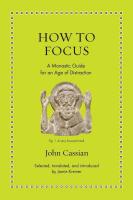
Princeton (2024) h/b £15 157pp £15 (ISBN 9780691208084)
This is another in the ‘Ancient Wisdom for Modern Readers’ series where a selection of texts on a topic is presented in the original on one side and translated (Loeb like) on the other. The texts are preceded by a brief introduction and followed by a few notes. The topic on this occasion is how to concentrate, and the editor is Jamie Kreiner, a professor of History at the University of Georgia, whose work centres on European Mediaeval history (particularly social and monastic).
She has made her selection from the Collationes of John Cassian (fl. AD 400) which is a 150,000-word guidebook on how to get the most out of a life of prayer and which later also became popular among mediaeval monks, often in an abridged or digest form. In his twenties, Cassian became a monk in Bethlehem alongside his great friend Germanus and later the two of them made a fifteen-year visit to Egypt to consult with various local gurus. He then served for a time in the archiepiscopal entourage of John Chrysostom in Constantinople before moving to Gaul where he wrote not only Collationes but also The Institutes (or how to be a monk). Although the thoughts probably reflect Cassian’s own conclusions, they are delivered as a description of discussions with various gurus (24 in all, of whom 7 are represented here).
Cassian and Germanus were, as monks, already aware of distractions and basic measures of dealing with them (avoiding, for example, ambition, money, food and drink—other than to survive—and sex). Their concern was rather how to concentrate even more deeply with the aim of entering an almost Buddhist style ‘out of body’ relationship with God which Cassian calls ‘fiery prayers’ (preces ignitae).
The gurus gave various answers. Abba Moses of Scetis recommends them never to forget their ultimate goal (‘fiery prayer’) when attempting to conquer the particular distraction which is currently worrying them. Abba Isaac also of Scetis recommends adopting a mantra. Abba Nestorus from Panephysis advises them to read holy scriptures incessantly. All the gurus concur that there is no quick fix, and that concentration must constantly be refreshed. The overall tone is very worthy and a bit self-congratulatory, as is the case in many self-help improvement manuals.
There are some lighter touches. Cassian says to one guru that he wants to go home to his family: at least there he will not be distracted by having to get his own food and doing the washing up. The guru replies that there is no place on earth, however remote, when he will not be assailed by distraction.
The original Latin text is fairly ornate and worthy, containing many long sentences, and K. struggles to make it more readable. She ensures that common technical terms are expressed in their contemporary idiom: for example, vitium is rendered as ‘weakness’ and puritas cordis as ‘tranquillity of heart’. Her attempts occasionally to lighten the tone by using modern American idiom is only partially successful (e.g. ‘bunkmate’ for contubernium). Her Introduction is both admirably concise and informative, as are her notes.
Overall, this is perhaps one of the less compelling topics in this series, if only because few readers will have as their goal the degree of concentration necessary to attain ‘fiery prayer’. But at £15 it will be enjoyed by those interested in the wider world of classical civilisation.
Roger Barnes
